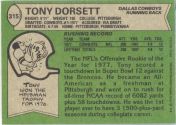1956 Topps FB # 1 Johnny Carson SHORT PRINT (Redskins)


Please wander around the website for more info, prices, values & images
on vintage baseball, football, basketball, hockey, sport and non-sports cards.
Randy Moss Football Cards
Click to view all of our
*** Vintage Football cards ***
|



1978 Topps FootballThe 1978 Topps Football set contained (528) cards. The set was jam packed with rookies including: Tony Dorsett, John Stallworth, Jim Smith...Note: You may be on that page right now. |



1987 Topps FootballThe 1987 Topps Football set contained (528) cards. Top rookies were Jim Kelly, Randall Cunningham, Doug Flutie, Herschel Walker...Note: You may be on that page right now. |

Like all collectibles, over time some sports cards go down in value, others go up and some can even become very valuable. Card values are based on many factors: player popularity, scarcity, condition & collector interest. A card can be scarce but without demand value may not be great.
Q: What are some ways to collect cards ?
* Complete sets by year & issue
* Cards of your favorite player
* Cards of your favorite team "TEAM SETS"
* Rookie cards
* Hall-of-Famer cards
* I even had a girlfriend that collected Don Mossi (checkout his ears),
players whose last name start with "Z", and the Brett brothers George &
Ken (she had a crush on George).
* "TYPE COLLECTING" (everyone should at least do a little of this !)
"Type Collecting"
is collecting at least one of each different "type" of issue.
On scarcer issues you can add a less expensive common
while on others you can select your favorite player or team.
